
The Guild Starfire bass is one of the more desirable vintage bass guitars of the 1960s, and gained recognition by its high profile users of the decade such as Jack Casady of Jefferson Airplane, Phil Lesh of the Grateful Dead, and Chris Hillman of the Byrds. It was a very well built thinline semi-acoustic bass, with a short (30") scale, and a rich woody tone - though with far less of the muddiness of the Gibson and Epiphone bass models that was its inspiration. The Starfire bass stood up well against hollow body rivals such as the Epiphone Rivoli, Gibson EB2 and Fender Coronado bass. There were two Guild Starfire bass models, the single pickup Starfire I, launched in 1965, and a dual pickup Starfire II debuting in 1967.
The Starfire pickups of the 1960s were made by Hagstrom (Bi-Sonic), and were very highly regarded. In fact it was the clarity of response of these pickups that meant Alembic kept these in place when modifying the circuitry of the Casady / Lesh basses of the late 1960s. The Hagstrom Bi-Sonic was a single coil unit, with a very unique design. Hagstrom had been fitting them to their Coronado solid body bass from 1963, but by 1966 had moved on to a new smaller unit. The Bi-Sonics continued to be fitted to Guild Starfire (and JS) basses until 1970, when Guild finally replaced them with their own brand new humbuckers. These are really great pickups, but for some reason, instruments fitted with these humbuckers are not as desired by collectors as older examples fitted with Bi-Sonics.
The earliest single pickup Starfire basses had a single pickup in the bridge position, with finger rests positioned above and below the strings in the neck position. Later (1966), these were reversed, with the pickup moving to the neck position (see a 1968 Starfire Bass I, also left).
The Starfire's bridge was also made by Hagstrom, and consisted of a metal baseplate with rosewood saddles. It remained a feature of the Starfire throughout it's production run, with only a slight shape change in 1968.
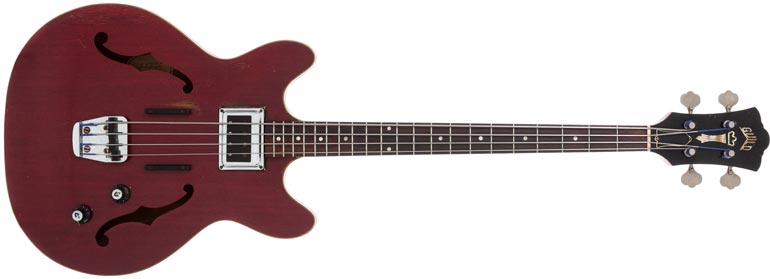
1966 Guild Starfire bass with single Hagstrom Bi-Sonic pickup Image Heritage auctions
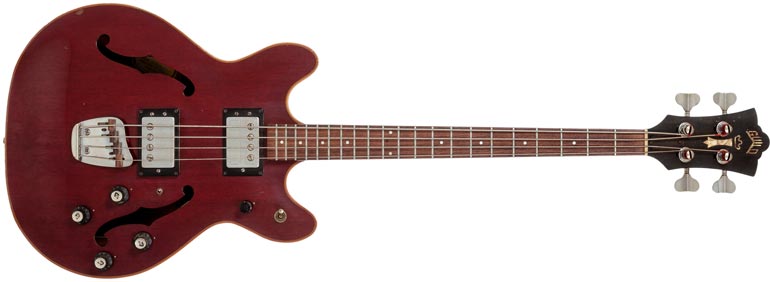
1975 Guild Starfire bass with dual Guild humbucking pickups Image Heritage auctions
The main features of the Starfire bass are summarised in the table below.
| Model | Starfire SF-I | Starfire SF-II |
|---|---|---|
| Available | 1965-1975 | 1967-1977 |
| Pickups | Hagstrom Bi-Sonic pickups, replaced by Guild humbuckers in 1970 | |
| Scale | 30 3/4" | |
| Width at nut | 1 1/2" | |
| Body | Bound Maple (Sunburst and Blonde finishes) or Mahogany (all other finishes). Width 16 3/8", 1 7/8" thin, length 20 1/4" (1968) 18" (1975). Overall length 46 3/4" | |
| Neck | Initially one-piece (later three piece) Peruvian Mahogany, rosewood 21 fret fingerboard with pearl dot position markers | |
| Hardware | Hagstrom bridge, Guild tuners, volume and tone control, hand rests | Hagstrom bridge, Guild tuners, 2 volume and 2 tone controls, master volume, pickup selector. Push-button bass boost, replaced by a tone switch in 1970 |
| Finishes | Sunburst, Cherry, Emerald Green, Ebony Grain, Amber, Brown, Black, Walnut, Blonde, Natural Mahogany | |
| Options | Fretless | Fretless and or stereo circuitry |
Some of the different variations of the Guild Starfire bass taken from catalog images over the period 1966-1975.
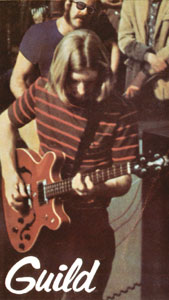 |
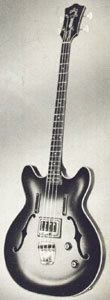 |
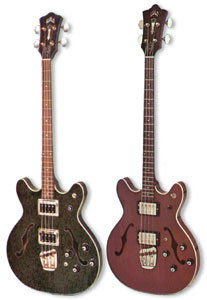 |
From left to right i) The Grateful Dead's Phil Lesh on the cover of the 1969 Guild catalogue; Cherry red Starfire bass II ii) 1965 Starfire I, with Hagstrom Bi-Sonic pickup in the bridge position iii) 1969 Starfire bass II in custom Emerald Green finish iv) 1975 Starfire II in Cherry finish. Taken from the 1975 catalogue. Note the new Guild humbuckers and larger headstock |
Click through to have a look at each vintage Guild catalog.
Electric bass advertisements originally published from 1965 onwards. Click on the images for larger copies. Check out other vintage Guild advertisements
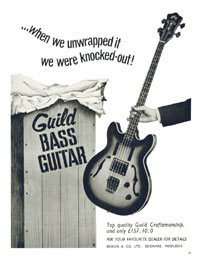
Guild Starfire - When we unwrapped it we were knocked-out (1965)
This very early Starfire bass advert (mid 1965) from British music magazine Beat Instrumental shows the single pickup Starfire bass with the Hagstrom bisonic pickup in the bridge position. The doub...
[more]
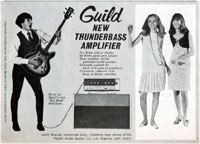
Guild Starfire - New Thunderbass amplifier (1966)
Half-page advert for the Thunderbass amplifier, also featuring Allan Montoya (Brooks Brothers) with a Starfire bass
[more]
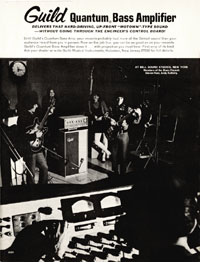
Guild Starfire - Guild Quantum Bass Amplifier (1967)
Delivers that hard-driving, up-front, "Motown"-type sound - without going through the engineers control board
1967 add showing two members of the Blues Project; Steve Katz playing a Guild Starfi...
[more]
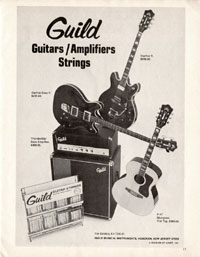
Guild Starfire - Guitars Amplifiers Strings (1970)
Features the Starfire V guitar, the Starfire bass II, Thunderstar bass amp, and the F-47 Bluegrass flat top
[more]
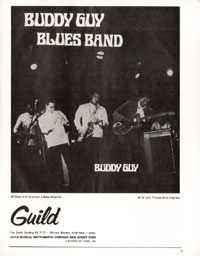
Guild Starfire - Buddy Guy Blues Band (1970)
1970 Guitar Player advert featuring Buddy Guy's band - Buddy uses a Starfire SF IV through a Thunderbird guitar amp. The bass player uses a Starefire SF bass through a Quantum X amplifier
[more]
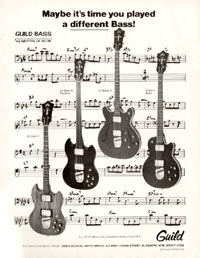
Guild Starfire - Maybe its time you played a different bass! (1972)
Black and white advert for the solid body JS II (fretted and fretless) and M-85 II basses, and the hollow body Starfire SF-bass II
[more]
$3000
€3500